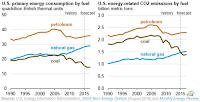- This year, carbon dioxide emissions from natural gas associated with the energy sector will exceed those from coal for the first time since 1972, according to the U.S. Energy Information Administration.
- Though coal is more carbon-intensive, increases in gas consumption and a reduction in coal-fired power mean mean the CO2 emissions from gas will be 10% greater this year, the agency said.
- Last year, natural gas consumption was 81% higher than coal consumption, and their carbon emissions were nearly equal. From 1990 to about 2005, consumption of coal and natural gas in the United States was relatively similar.
Natural gas is less carbon-intensive than coal, but as environmental advocates have been pointing out for years, the fuel still has significant emissions related to its use. And now, for the first time in about 45 years, those emissions from gas are set to exceed coal's.
It's a striking statistic that points to just how markedly the power sector has changed, and how much of the country heats and generates power with natural gas.
According to EIA's latest Short-Term Energy Outlook, energy-related CO2 emissions from natural gas will be 10% greater than those from coal in 2016. The agency said gas consumption results in about 52 million metric tons of CO2 for every quadrillion British thermal units, while coal's carbon intensity is about 95 MMmtCO2/quad Btu — more than 80% higher than gas's carbon intensity, on average.
"Annual carbon intensity rates in the United States have generally been decreasing since 2005," EIA said in a research note posted this week. As the country has shifted away from coal, that has helped lower the carbon-intensity measure.
"Another contributing factor to lower carbon intensity is increased consumption of fuels that produce no carbon dioxide, such as nuclear-powered electricity and renewable energy," EIA said. "As these fuels make up a larger share of U.S. energy consumption, the U.S. average carbon intensity declines."
Read more at EIA: Energy-Related CO2 Emissions from Natural Gas Will Surpass Coal in 2016

No comments:
Post a Comment